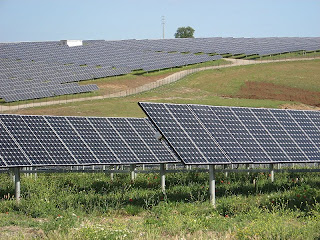Energy and Land Use
Both the article and the report make it clear that options such as increased use of biomass and wind have significant implications for land use. In an era of NIMBY (Not in My Backyard), BANANA (Build Absolutely Nothing Anywhere Near Anyone), and NOPE (Not on Planet Earth), the land use ramifications should be prominently considered.
The full report has helped clarify some issues that have always puzzled me. For example, claims of significant land use by windmills have sometimes seemed specious, as windmills can often be cited on farmland, which would appear to allow for dual use of the same land. Thus, from that perspective, land use would not seem to be a significant issue for windmills. However, the report notes that the full land impact takes into account more than the human uses of the land. The report estimates that the direct footprint of windmills is 3-5% of the total affected area. Fragmenting habitats and species avoidance behavior account for 95-97% of the total footprint. What is not clear is how this figure was derived and whether it applies to land that is already used for agricultural purposes. Even if the ratio is lower in some cases (as I believe would be appropriate for land already in use), it makes the point that the impact of a windmill exceeds its physical footprint.
In addition, I might add that many people apparently consider windmills unsightly, and increasingly, laws are being passed to restrict their siting. So far, these laws mainly have to do with concerns about destroying scenic, natural environments, and thus, prohibit siting on mountain ridges. The most recent example is legislation in North Carolina. However, some reports are beginning to emerge that attribute a variety of health effects to wind turbines. While I see no evidence that these claims are credible, they may result in increasing restrictions on siting. There are other options, such as offshore siting, but these increase costs and potential impacts on migratory birds.
The report also covers land use issues for other energy sources. In particular, an increased use of biomass for energy generation has potentially the largest impact on land use. It covers this scenario in some detail, and in particular, notes some of the interactions with food production requirements. Using land presently used for food production would not create new land use impacts. However, it is likely that other land would have to be devoted to food production, so the land use would increase in one way or another. The alternative--increased food costs and/or food shortages-have different, but equally undesirable, impacts.
The report gives less space to the energy sources that have the lowest land use impacts, but readers of this blog will be happy to know that nuclear power was the least energy-intensive energy source. Only energy efficiency measures had a lower land use impact.
As always, I would emphasize that no one measure can give us a true sense of the pros or cons of an energy technology. Nuclear power proponents should not react gleefully to the fact that wind is more land intensive or that it has its own detractors. But by the same reasoning, proponents of wind or solar power should not cast their technologies as the sole solution to our energy needs. Land use issues are only one of a number of issues that will have to be balanced to find an appropriate mix of technologies for the future.






No comments:
Post a Comment